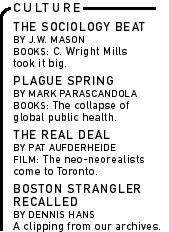
|

|

|

|
| |
|
|
|
Betrayal of Trust: The Collapse of Global Public Health
Last spring, the Clinton administration declared the global spread of AIDS to be a national security threat. The continuing spread of the disease in Africa, Asia and the former Soviet Union could, the White House said, topple governments, spark ethnic wars and undo progress toward democracy. The link between epidemics in distant places and U.S. national security may seem tenuous; after all, it was not the spread of AIDS in the United States that the administration feared so much. Nevertheless, Laurie Garrett would likely reply that Clinton's declaration was too little, too late. Garrett's first book, The Coming Plague, appeared in 1994 amidst growing public fascination with obscure infectious diseases. That same year, with the publication of Richard Preston's The Hot Zone, a new subgenre of horror story had been born. These were true tales of terrifying diseases (Ebola, Lassa fever, Marburg virus), and they made heroes of globetrotting epidemiologists. At the same time, news reports about new, drug-resistant strains of tuberculosis in U.S. cities were on the increase. The timing could not have been better for Garrett's predictions of global doom. After the book's publication, talk show hosts and fellow journalists plied her for solutions. How could disaster be averted? Looking back, she writes, "As a journalist I felt uncomfortable: It wasn't my role to solve society's dilemmas, only to describe them." Nevertheless, she saw reason to delve further and explore the underlying causes of what had become a global predicament. Her second book, Betrayal of Trust: The Collapse of Global Public Health, is the result of six years of those efforts. The book opens with a recent epidemic of bubonic plague in India. In the early '90s,
Garrett insists that it was not the fleas, rats or earthquake that were to blame for the chaos that followed. Instead, she uses the incident to demonstrate how a chain of unexpected events and poor decisions can turn a local outbreak into a national crisis. India's public health protections had been weakened by aggressive budget cuts in the early '90s. During this period of growing economic prosperity, officials played down the importance of public health surveillance and preventive measures. "We have beautiful antibiotics. This is not the Middle Ages," said Maharashtra's state health minister Subash Salunke. But while officials remained dangerously calm, others panicked. When plague cases began turning up at hospitals in the industrial city of Surat, private doctors fled the area. Within a week, 500,000 residents followed suit, taking the plague with them (and watching curiously as one Western journalist, Garrett herself, passed them going in the opposite direction). As word spread throughout the Indian subcontinent, antibiotic supplies were snapped up, even in areas where they were clearly not needed. Urgent news reports, full of misinformation, further spread fear. The Bombay stock market crashed, several nations banned all flights and trade with India, and others began to screen travelers and spray planes with pesticides. Amazingly, all this transpired before the original plague diagnoses had been confirmed in a laboratory. Garrett makes a strong case that both Indian and international authorities behaved less than rationally, multiplying India's economic losses. But the danger from such a catastrophe is not confined to India. Indeed, what makes distant outbreaks into Hollywood movie material is the possibility that they could turn up in our own neighborhoods. After all, bacteria don't recognize national borders. As international trade and travel become faster, cheaper and more frequent, ambitious microbes are being handed, literally, a world of opportunity. As the late public health luminary Jonathan Mann wrote in his preface to The Coming Plague, "We can already predict the future--and it is threatening and dangerous to us all." But there is another, even more profound, worry contained in the subtitle to Garrett's new book--"The Collapse of Global Public Health." Garrett insists that local outbreaks are not simply isolated incidents or consequences of momentary lapses of vigilance. Instead, they are symptoms of a widespread malaise that has infected public health "infrastructure" (she cringes at the term herself) around the globe. She traces this from Ebola in Zaire to syphilis and tuberculosis in the former Soviet Union. Through budget cuts, negligence and lack of political will, public health infrastructure everywhere is in dire straits, and the United States is no exception. Unfortunately, this is where Garrett's argument loses focus. Of the 200 pages devoted to the United States, half consist of a wandering history that does little to illuminate exactly where public health has gone astray. Memorable but unrelated images and anecdotes (remember President Bush holding up a bag of crack purchased across the street from the White House?) are juxtaposed in a patchwork style, as if cut and pasted from years of her reporting. Like The Coming Plague, the book is meticulously researched, but, also like that other book, its 742 pages could benefit from some aggressive editing. A few broad themes do emerge, however. A distinctly American infatuation with costly, technological solutions and individual responsibility has created a myopic vision of public health, one that does not lend much support to massive disease prevention and surveillance programs. These attitudes, along with Reagan-era budget slashing, have crippled U.S. public health mechanisms. As Garrett writes, "The individualized and medicalized approaches no longer made sense at the close of the twentieth century." But some of the blame must go to public health practitioners themselves. Nagged with self-doubt, they can't seem to agree on what their own obligations are. In its 1988 report on "The Future of Public Health," a National Academy of Sciences committee provided only a hopelessly vague definition: "The committee defines the mission of public health as fulfilling society's interest in assuring conditions in which people can be healthy." In other words, public health is anything that helps people to be healthy. As a call to action, that definition leaves something to be desired. Public health practitioners might learn a thing or two from observing their own history. In 1914, U.S. public health service officer Joseph Goldberger was called to head an investigation of pellagra in the South. He famously demonstrated that pellagra was caused by dietary deficiency through a series of inventive human experiments. But he went a step further and insisted that the real cause of pellagra was epidemic poverty, a conclusion that did not please his southern hosts. Goldberger lacked diplomacy, but he did recognize that public health practitioners should not shy away from taking a political stand. In today's public health journals, researchers argue about whether they should study social phenomena, such as poverty and "neighborhood quality," or restrict themselves to biology. While new genetic technologies of the past 20 years have come to dominate public health research, disparities in health between social groups have grown ever harder to ignore. Much of the future of public health rests on how public health leaders can manage to unite these very different trends. Garrett's prescription is that "public health needs to be--must
be--global prevention." Presumably, this means more money for public
health infrastructure around the world, which is surely a good thing
(if, that is, the public health community can agree on how to spend
it). As with her first book, however, she does not have detailed
solutions at hand. Nevertheless, this book is full of horror stories
of the type that will surely keep public health policy wonks awake
for nights on end. Mark Parascandola is a graduate student in public health at Johns Hopkins University. His writing has appeared in Lingua Franca and the Washington Post.
|


